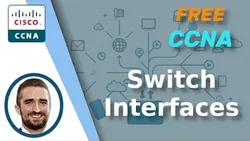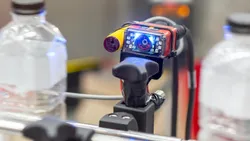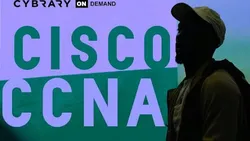
Free CCNA Switch Interfaces Day 9 CCNA 200-301 Complete Course 
This lesson covers the comparison between switches and routers, network topology, and the commands used to configure interface speed and duplex. It also explains the 'show ip interface brief' and 'show interfaces status' commands. Students will gain an understanding of how to configure switch interfaces and how they differ from router interfaces. ▼
ADVERTISEMENT
Course Feature
![]() Cost:
Cost:
Free
![]() Provider:
Provider:
Youtube
![]() Certificate:
Certificate:
Paid Certification
![]() Language:
Language:
English
![]() Start Date:
Start Date:
On-Demand
Course Overview
❗The content presented here is sourced directly from Youtube platform. For comprehensive course details, including enrollment information, simply click on the 'Go to class' link on our website.
Updated in [February 21st, 2023]
What does this course tell?
(Please note that the following overview content is from the original platform)
Introduction.
Things we'll cover.
Switch/Router comparison.
Network Topology.
'show ip interface brief'.
Router vs Switch interfaces.
'show interfaces status' command.
Configuring interface speed and duplex.
'interface range' command.
Full/Half Duplex.
Ethernet Hubs.
CSMA/CD.
Collision Domains.
Full/Half Duplex review.
Speed/Duplex Autonegotiation.
Interface Errors.
Things we covered.
Quiz 1.
Quiz 2.
Quiz 3.
Quiz 4.
Quiz 5.
We consider the value of this course from multiple aspects, and finally summarize it for you from three aspects: personal skills, career development, and further study:
(Kindly be aware that our content is optimized by AI tools while also undergoing moderation carefully from our editorial staff.)
This course provides an introduction to the fundamentals of CCNA Switch Interfaces. It covers topics such as switch/router comparison, network topology, 'show ip interface brief', router vs switch interfaces, 'show interfaces status' command, configuring interface speed and duplex, 'interface range' command, full/half duplex, Ethernet hubs, CSMA/CD, collision domains, full/half duplex review, speed/duplex autonegotiation, interface errors, and quizzes.
Learners of this course can develop their career paths in the field of networking, such as network administrator, network engineer, network analyst, network technician, and system administrator. They can also pursue further education in the field of computer science, information technology, and network security.
Learning Suggestions for learners include studying related topics such as IP addressing, routing protocols, network security, and network troubleshooting. They should also practice configuring and troubleshooting networks in a lab environment. Additionally, they should take advantage of online resources such as tutorials, forums, and blogs to stay up to date with the latest networking technologies.
[Applications]
After completing this course, participants should be able to apply the knowledge they have gained to configure and troubleshoot switch interfaces. They should be able to understand the differences between router and switch interfaces, as well as the differences between full and half duplex. They should also be able to use the 'show ip interface brief' and 'show interfaces status' commands to view interface information. Additionally, they should be able to configure interface speed and duplex, as well as use the 'interface range' command. Finally, they should be able to identify and troubleshoot interface errors.
[Career Paths]
Three recommended career paths for learners of this course are:
1. Network Engineer: Network Engineers are responsible for designing, implementing, and maintaining computer networks. They must have a strong understanding of network topology, routing protocols, and switching technologies. Network Engineers must also be able to troubleshoot and resolve network issues. With the increasing demand for cloud computing and virtualization, Network Engineers must stay up-to-date on the latest technologies and trends.
2. Network Administrator: Network Administrators are responsible for the day-to-day operations of a network. They must be able to configure, monitor, and maintain network devices such as routers, switches, and firewalls. Network Administrators must also be able to troubleshoot and resolve network issues. With the increasing demand for cloud computing and virtualization, Network Administrators must stay up-to-date on the latest technologies and trends.
3. Network Security Engineer: Network Security Engineers are responsible for designing, implementing, and maintaining secure networks. They must have a strong understanding of network security protocols, encryption technologies, and authentication methods. Network Security Engineers must also be able to troubleshoot and resolve network security issues. With the increasing demand for cloud computing and virtualization, Network Security Engineers must stay up-to-date on the latest technologies and trends.
Course Provider

Provider Youtube's Stats at AZClass
Over 100+ Best Educational YouTube Channels in 2023.
Best educational YouTube channels for college students, including Crash Course, Khan Academy, etc.
AZ Class hope that this free Youtube course can help your Cisco Certification skills no matter in career or in further education. Even if you are only slightly interested, you can take Free CCNA Switch Interfaces Day 9 CCNA 200-301 Complete Course course with confidence!
Discussion and Reviews
0.0 (Based on 0 reviews)
Explore Similar Online Courses

Anaconda Python Python Anaconda Tutorial Anaconda Installation Great Learning

PLC: Industrial Sensors

Python for Informatics: Exploring Information

Social Network Analysis

Introduction to Systematic Review and Meta-Analysis

The Analytics Edge

DCO042 - Python For Informatics

Causal Diagrams: Draw Your Assumptions Before Your Conclusions

Whole genome sequencing of bacterial genomes - tools and applications

CCNA (Cisco Certified Network Associate) Course

Packet Tracer labs for the CCNA 200-301 exam: Practical labs


Start your review of Free CCNA Switch Interfaces Day 9 CCNA 200-301 Complete Course